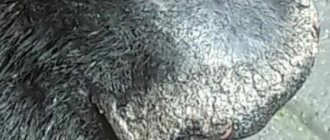How can you tell if your dog is vomiting bile?
Bile itself is very important for the functioning of the gastrointestinal tract. Why? Without it, the digestion process will not work properly, which will lead to dystrophy, metabolic disorders, etc. If the dog has a strict feeding regime, then bile is released according to the morning-evening schedule. It is produced in the liver and accumulates in the gallbladder, from where it enters the small intestine, where its effect is manifested.
Bile breaks down (emulsifies) fats, after which their beneficial components can be absorbed in the small intestine. Bile stimulates intestinal motility and blocks pepsin (a stomach enzyme) in the intestines. It is dangerous for pancreatic enzymes. It is important to note its high level of acidity (pH 6.5-6.8). The intestinal mucosa works great with bile, but when it gets into the stomach, esophagus, and especially the pharynx and oral cavity, a strong effect occurs - it bakes a lot!
If your dog is vomiting bile and not eating anything, most likely he has problems with the liver, gall bladder, and gastrointestinal tract in general. Bile in such vomit is easily recognizable - individual clots of yellow (yellow foam), yellow-green, dark green color in the mucus. The phenomenon is accompanied by a sharp, pungent, sour odor of the bile itself. When there is an urge to vomit, it seems that the dog is vomiting from the very depths of the gastrointestinal tract. The dog bends unnaturally and vomits not the first time, but 3-5 times. Vomiting of bile with yellow foam is observed with gastrointestinal reflux (reverse flow of the contents of hollow organs compared to the normal direction), poisoning, hepatitis and other diseases.
Possible causes of vomiting
Vomiting (vomitus) - cleansing, evacuation of the contents of the stomach, sometimes the small intestine. Vomiting can be both physiological (within the normal functioning of the body) and pathological (due to poisoning, infections, ulcers, etc.). Vomiting and its severity can be differentiated by visual examination of the contents - edible food, stagnant contents, bile, pus, intestinal contents, coffee grounds, mixed with blood. Vomiting within the framework of physiology is repeated once or twice. Pathological vomiting is systematic in nature and can be repeated in attacks several times a day. The dog looks extremely bad and its internal discomfort is visible.
Isolated cases
If you see that the dog has vomited food and is trying to eat it back (appetite is not affected), the masses are of normal color and smell - this is physiological vomiting, associated, for example, with overeating. It occurs when changing the diet (for example, switching from dry food to natural food), when the stomach is not yet accustomed to digesting, for example, beef or tripe. Or, when a dog eats leek grass and then vomits a clot of grass, mucus, and gastric juice, feeling simply excellent, then this is also within the norm.
Dogs are carnivores, and their livers are especially developed compared to humans and other animals. Sometimes the body cleanses itself of excess bile, cleanses the gallbladder (prevention of stones) and ducts. Then the dog vomits bile and foam. If this occurs 1-2-2 times and goes away completely, then there is no need to worry. If the process continues and the condition worsens, then this is a sign of poisoning; refusing food will confirm your fears! You can arrange a fasting day and a fasting diet for 12 hours. This also happens with mild poisoning. The body fights on its own, as nature intended.
If vomiting recurs systematically
In the case when vomiting becomes regular, constantly occurs depending on the time of day, occurs at a certain time before or after meals, and the contents look extremely unhealthy, then there is a reason to sound the alarm, go to the veterinarian, or act independently with the appropriate skills.
The reasons for this phenomenon may be:
- poisoning,
- hepatitis,
- cholecystitis,
- ulcerative processes,
- poisoning,
- gastrointestinal infections,
- oncology.
It is very important to go to the clinic and do a comprehensive examination of your pet. In any case, you should not hope that everything will go away by itself. Delay can only aggravate the dog’s already difficult situation. This is especially true for young animals. Repeated vomiting, vomiting with yellow foam (not an isolated case), before, after and during meals, vomiting of bile in a puppy, etc. requires immediate contact with a veterinarian!
Important! Very often, the cause of systematic vomiting is a foreign object in the animal’s stomach!
In what cases is vomiting normal?
Physiological vomiting, as a natural reflex, can be observed in a dog in the following cases:
- stressful situations - moving, new owners, unusually noisy environment, trip to the veterinary clinic, etc.;
- overeating – a dog vomits after eating if the owners have fed the dog until it’s full;
- hot weather;
- motion sickness in transport;
- sudden change in diet;
- eating stale food.
We are talking specifically about a single vomiting, when the animal feels absolutely normal and its behavior does not change. In these cases, there is no need to treat vomiting in a dog; the body will “do everything itself.”
If you experience diarrhea, fever, loss of appetite, extreme thirst/refusal of water, or other alarming symptoms, you should not delay a visit to the veterinarian. Vomiting may be one of the clinical manifestations of a serious pathology.
What symptoms still need to be paid attention to?
If an animal exhibits a gag reflex, it is very important to monitor its body temperature and conduct thermometry. This simple trick will warn you of danger. Low temperature is a symptom of severe exhaustion, electrolyte imbalance in the body, poisoning with heavy metals, opiates, exacerbation of chronic diseases, severe bleeding.
An increase in temperature indicates the onset of the inflammatory process, the development of infections of various natures, the formation of ulcers, etc. The animal refuses food, and damage occurs to the liver, gastrointestinal tract, and pancreas. It is important to monitor, as described above, the nature of the vomit. Also, do not forget to monitor the feces - consistency, color (white, gray, brown, greenish), admixtures of mucus, gases, blood.
The dog may vomit, and at the same time it bends over, looking for a dark place. Keep track of how much and how often your dog drinks. A large amount of water consumed may indicate severe infections with increased body temperature, ulcers at different stages of development, and gastrointestinal oncology. Low fluid intake indicates an extremely depleted state of the body, inflammation of the oral cavity, pharynx, esophagus, stomach, diabetes mellitus, and various oncologies that cause pain when drinking. Monitor your dog's appetite and whether he eats what he prefers.
Diagnostics
The owner must inform the veterinarian of all the symptoms he observes. You need to remember whether your pet has suffered from any diseases of the gastrointestinal tract, and whether he has eaten something “wrong” recently (chicken bones, for example). It is very important to remember exactly when the vomiting appeared, and after what exactly it happened.
The veterinarian will perform a complete examination of your pet. A complete blood and urine test is required, since the data obtained from this helps to identify severe diseases of the gastrointestinal tract.
As a rule, vomiting often accompanies many infectious diseases, which are quite accurately determined during the tests described above. If nothing can be reliably determined, the veterinarian resorts to x-ray and ultrasound examination of the abdominal cavity of the sick animal.
It is important to note that before an X-ray examination, it is imperative to feed the dog barium gruel: this way, cases of gastrointestinal obstruction, intestinal volvulus, gastrointestinal atony, etc. can easily be identified. In addition, gastroendoscopy is indicated.
How can you help your dog with vomiting at home?
At the first sign of vomiting, you should immediately stop feeding your dog anything, especially puppies. After fasting, give some dietary food on an empty stomach. Vomiting contributes to the loss of electrolytes from the body. It is very important to maintain electrolyte balance; to do this, we give the dog a solution of soda and salt (a very weak solution) or a drug from a pharmacy like Humana.
Vomiting distends the stomach. Therefore, we eat often and in small portions. Monitor your dog’s body temperature: 37.5-39 is normal for a dog! If diarrhea is observed, then we resort to activated carbon, the drug enterosgel, etc. If the temperature rises and vomiting with diarrhea increases, you can resort to antibiotics such as streptocide tablets, Bicilin 3 (do it intramuscularly in severe cases).
What to give your dog for vomiting bile? Often in folk medicine they resort to pouring 1-2 tablespoons of vodka into the oral cavity. Is it possible to treat this way? The bottom line is that alcohol in small doses greatly stimulates digestion through the secretion of gastric juice, relieves inflammation, and tones the animal’s body. For atony, fermentation processes, and simple poisoning in healthy dogs, this is a very effective remedy.
Herbal decoctions of chamomile, St. John's wort, wormwood, etc. have proven themselves to be effective. To do this, the raw materials are poured with warm boiled water and boiled for 30 minutes, then left for another 10 minutes, cooled, filtered and the medicine is ready. Analgin with diphenhydramine intramuscularly will help relieve spasms and bring down high fever, cerucal and noshpa will relieve the gag reflex and calm peristalsis.
If the animal's condition worsens, contact a veterinary clinic immediately!
Diet
What to do at home before the veterinarian arrives? Be sure to give your pet water as often as possible to prevent dehydration. In the first day after illness, the dog does not need to be fed; it is better to keep it on a starvation diet until it feels better. In the following days, give rice water, which envelops the inner walls of the digestive canal and protects them from damage.
In the future, the diet is expanded with boiled porridges, they are given 1-2 spoons. At the next meals, offer your pet boiled pureed meat or boneless poultry, low-fat cottage cheese. The only fruits allowed are apples and bananas.
The amount of food during the acute period is halved.
Upon recovery, they return to their normal diet.
What medications can be used?
Vomiting does not stop, diarrhea begins, yellow foam appears, or the dog is vomiting bile, how to treat it? Preparations from a regular human pharmacy will do. You can safely follow the doses indicated in the attached instructions (large dogs - adult doses, medium - for teenagers, small - like for small children).
It is important to remember that antipyretics can harm your dog and should be used as a last resort.
Otherwise, the following medications will be required:
- no-shpa,
- diphenhydramine,
- papaverine.
They will relieve spasms and relieve pain.
Will help with intoxication:
- smecta,
- enterosgel,
- absorbent carbon.
Metoclopromide and cerucal normalize peristalsis. Contrical will calm the pancreas. Omeprazide, omeprazole, omez calm the gastrointestinal tract and counteract vomiting. The herbs of chamomile, St. John's wort, and wormwood are used according to the instructions. They often help cure the animal.
conclusions
Vomiting can be either physiological or pathological. With pathology, there is a refusal to feed, exhaustion, the temperature regime is disturbed, the stool changes, an infection develops, etc. Such vomiting is long-term and gets worse. The appearance of bile in the vomit indicates damage to the liver and gallbladder. Human medications other than antipyretics and analgesics are suitable for first aid and treatment. It is important to monitor the dog’s general condition, appetite, how much the dog drinks, what type of stool, and the nature of the vomit. At the first sign of vomiting, stop feeding the dog, this will relieve the burden on the gastrointestinal tract and the body.
Please follow and like us:
Nikitin Sergey
I write about dogs based on the experience and knowledge gained during my studies as a veterinarian, work in my specialty, and simply from observing my pets.
Prevention
It is impossible to completely avoid the occurrence of nausea, but by following simple rules you can reduce the risk of its occurrence. First of all, you need to pay attention to feeding your pet. The puppy should be fed only high-quality and balanced food, avoid spicy, sweet and smoked foods. In addition, it is recommended to minimize the occurrence of stressful situations.
To prevent infection with infectious diseases and helminthic infestations, the animal must be regularly vaccinated and dewormed. To avoid poisoning by toxic substances, try to closely monitor your pet (do not allow him to pick up food on the street, hide medications and household chemicals).
Sudden onset of vomiting does not always indicate pathological processes in the pet’s body. But if the urge continues for a long time and is accompanied by additional symptoms, the animal in most cases requires the help of a veterinarian.










